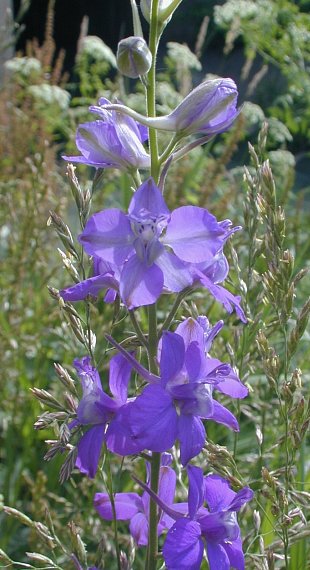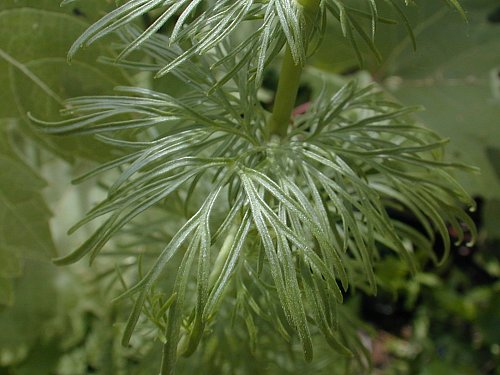 Description:
This annual plant is about 2-3' tall. It often produces 2 or
3 forking stems that are themselves little branched. These stems are
round and pubescent, although with age they often become glabrous. The
alternate leaves are sessile, palmately divided, and up to 3" long and
across. Their lobes repeatedly subdivide into smaller lobes that are
narrowly linear, providing the leaves with a lacy appearance. They are
slightly pubescent and often have a silky appearance. The stems
terminate into spike-like racemes of blue-violet flowers. These racemes
can be up to 1' in length. Each flower is about 2" across, consisting
of 5 petal-like sepals, 4 petals, a single pistil, and some stamens
with light blue anthers. The upper sepal forms a hood in front and an
upward-curving spur in back about 1" long. The middle and lower sepals
are well-rounded and spreading. The 2 upper petals form a protective
inner hood of the reproductive organs; they are not fused together. The
2 lower petals form a V-shaped landing pad for visiting insects. The
outer sepals are larger in size than the inner petals. At the base of
each flower is a slender pedicel about 1" long. The blooming period
occurs during the summer and lasts about 1-2 months. Each flower is
replaced by a pubescent follicle containing numerous small black seeds.
These seeds are small enough to be dispersed by gusts of wind. The root
system is a slender branching taproot. This plant spreads by reseeding
itself, and may form colonies at favorable sites, although it usually
doesn't persist.
Description:
This annual plant is about 2-3' tall. It often produces 2 or
3 forking stems that are themselves little branched. These stems are
round and pubescent, although with age they often become glabrous. The
alternate leaves are sessile, palmately divided, and up to 3" long and
across. Their lobes repeatedly subdivide into smaller lobes that are
narrowly linear, providing the leaves with a lacy appearance. They are
slightly pubescent and often have a silky appearance. The stems
terminate into spike-like racemes of blue-violet flowers. These racemes
can be up to 1' in length. Each flower is about 2" across, consisting
of 5 petal-like sepals, 4 petals, a single pistil, and some stamens
with light blue anthers. The upper sepal forms a hood in front and an
upward-curving spur in back about 1" long. The middle and lower sepals
are well-rounded and spreading. The 2 upper petals form a protective
inner hood of the reproductive organs; they are not fused together. The
2 lower petals form a V-shaped landing pad for visiting insects. The
outer sepals are larger in size than the inner petals. At the base of
each flower is a slender pedicel about 1" long. The blooming period
occurs during the summer and lasts about 1-2 months. Each flower is
replaced by a pubescent follicle containing numerous small black seeds.
These seeds are small enough to be dispersed by gusts of wind. The root
system is a slender branching taproot. This plant spreads by reseeding
itself, and may form colonies at favorable sites, although it usually
doesn't persist.
Cultivation:
The preference is full sunlight, moist to mesic conditions, and a loamy
fertile soil. This plant develops quickly, shooting up like a rocket,
hence the common name. However, in poor soil and droughty conditions,
growth will be stunted.
Range & Habitat:
Rocket Larkspur is an occasional plant that has been reported from
scattered counties in Illinois, except in the NW area of the state (see
Distribution
Map). Habitats consist of areas along railroads and
roadsides, banks of drainage ditches, abandoned fields, vacant lots,
and flower gardens. There is a strong preference for disturbed areas;
it does not appear to invade higher quality natural habitats to any
significant extent, at least in Illinois. Rocket Larkspur originated
from the Mediterranean area of Europe; it was introduced into the
United States as an ornamental plant.
Faunal Associations:
Long-tongued bees pollinate the flowers, especially bumblebees.
Butterflies may visit the flowers occasionally, but they are unlikely
to be effective at pollination. The larvae of a fly, Phytomyza delphinivora,
mine the leaves of Consolida
spp. (larkspurs), and the caterpillars of a polyphagous
moth, Megalographa
biloba (Bilobed Looper Moth), also feed on the foliage
(Cranshaw, 2004; Wagner, 2005). Because of the presence of an alkaloid,
delphinine, both the foliage and small seeds are quite toxic.
Therefore, they are of little value as a food source to birds and
mammals. Like the closely related Delphinium spp.
(delphiniums), the larkspurs occasionally poison livestock.
Photographic Location:
The lower bank of a large drainage ditch in Urbana, Illinois.

Comments: Rocket Larkspur produces attractive flowers on long spike-like racemes, therefore it is not surprising that this species is grown in flower gardens, from which it occasionally escapes. Unlike the Delphiniums, which are perennial plants, the Consolida spp. (Larkspurs) are annual plants. While the flower of a Delphinium has 3 pistils, the flower of a Larkspur has only a single pistil. The only other Larkspur that escapes into the wild in Illinois is Consolida regalis (Forking Larkspur). This is another introduced plant from the Mediterranean area of Europe that is less commonly encountered than Rocket Larkspur. Its flowers are often a lighter shade of blue-violet than Rocket Larkspur, and the upper petals of its flowers are fused together. The follicles (seed capsules) of Forking Larkspur are glabrous, while the follicles of Rocket Larkspur are pubescent.